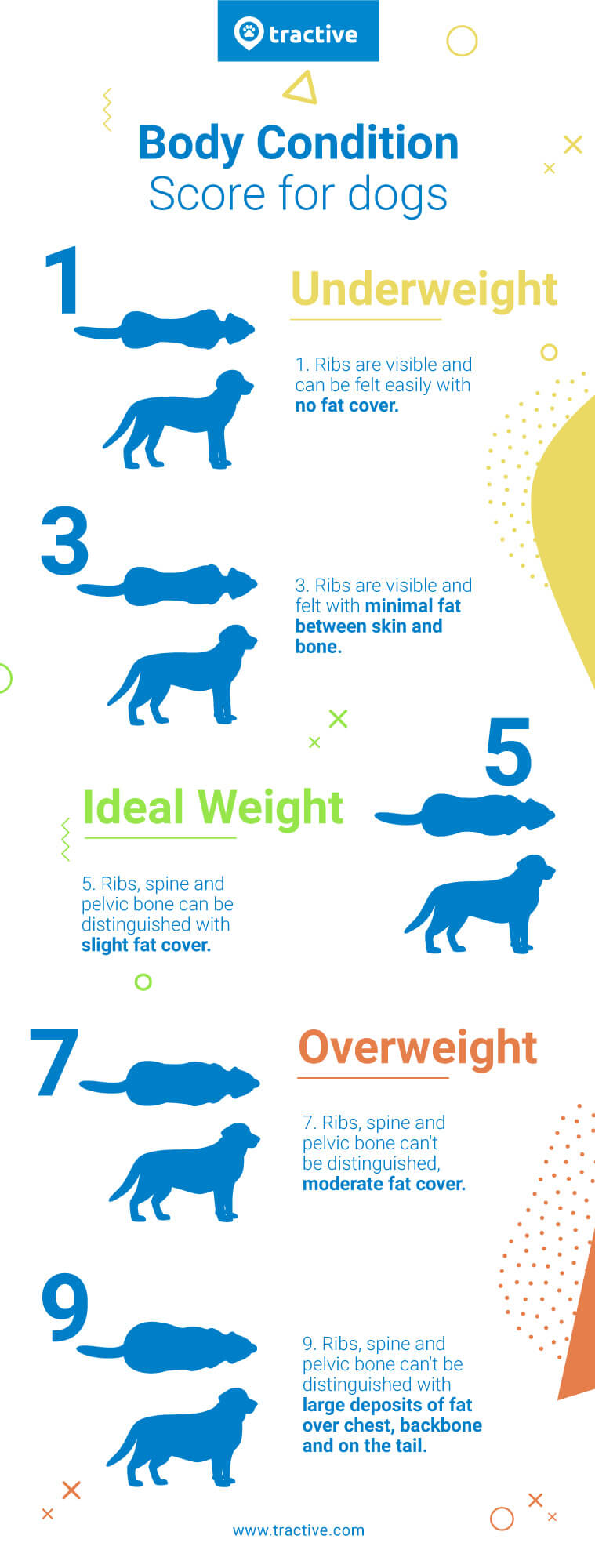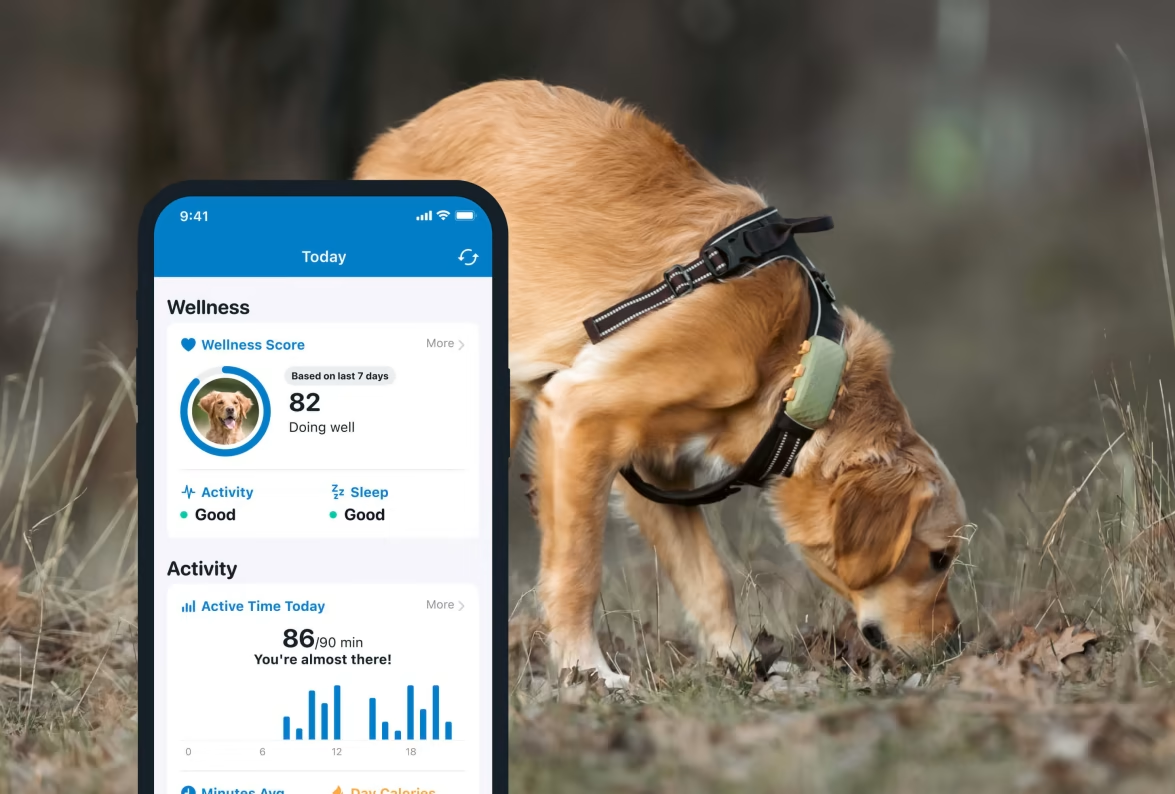Body Condition Score & BMI Calculator for Dogs
Is your dog underweight, overweight, or at the ideal weight? Find out now using the BMI calculator and Body Condition Score for dogs from Tractive.

If you suspect your dog might have a weight issue, or if you just want to confirm that your dog’s weight is normal, keep reading. Find out if your dog’s weight is healthy using the Body Condition Score dog rating and dog BMI calculator below. While you’re here, get some tips on how to help your dog lose weight and how tracking their activity can help you both stay motivated.

Find out how your dog spends their time.
Read moreDog BMI Calculator
One way to determine if your dog’s weight is healthy is to calculate your dog’s BMI. It stands for Body Mass Index and is a measure of body fat, calculated based on weight and height1. It is most commonly used to determine if a person’s body weight is considered healthy, but can also be applied to our furry friends. Knowing your dog’s BMI will tell you if your dog (at their current weight) is considered underweight, normal, overweight, or obese.
The following simple formula is used to calculate a person’s BMI:
Weight / Height2
However, when calculating a dog’s BMI, it’s not as simple. You’ll need to consider factors such as the breed, age and sex of your dog as well. Luckily, you don’t have to do all that yourself. You can just use our BMI calculator for dogs and find out which weight category your dog falls under.
Tractive’s BMI Calculator for Dogs
Body Condition Score for dogs
Another common way to measure a dog’s weight condition is by using the Body Condition Score chart for dogs. This method of determining if your dog is overweight or underweight is even simpler than the BMI calculator, and doesn’t require details like birth date, breed, height or weight. Here’s how you can use it:
- With your dog standing on all four legs, view your dog’s body from above and the side; noticing the amount of visible fat and/or bones on each side.
- Gently run your hands along the top and sides of your dog’s chest and rib cage. Do you feel mostly fat, or can the ribs be felt easily?
Compare your results with the chart below to identify your dog’s Body Condition Score:

The middle value (5) represents the ideal, healthy dog weight. In this best case scenario, you can feel your dogs ribs, spine, and pelvic bone but there is still a bit of fat cover. Scores below 5 are in the underweight range, while scores above 5 are considered overweight.
If your dog’s body condition matches those on the extreme ends of the scale (1 or 9) your dog may be considered malnourished or obese. In either case, get in touch with your vet as soon as possible.
Is my dog fat? 6 factors that impact a dog’s weight
Sadly, more and more dogs are overweight or obese these days. In fact, there’s a growing pet obesity problem in the United States.2 Your dog’s weight can depend on factors like:
- Breed predisposition
- Lifestyle of pet parents
- Age
- Neutering
- Nutrition
- Activity levels
Read more:
- What Makes Dogs Fat? Getting An Overweight Dog Back In Shape
- How Much Exercise Does A Dog Need?
- How Often Should You Walk Your Dog?
How to maintain a healthy dog weight
Dogs with extra weight will have an increased load on virtually all organs of the body. When the organs are overloaded, it can lead to disease – sometimes even death. Keeping your pet active, and within the limits of the weight scale, is not just for fun, it’s actually life-saving. That’s why we would recommend putting the following advice into practice, and help your dog maintain a healthy weight.
Help your dog reach their ideal weight
Before you can help your dog maintain their healthy weight, you need to help them achieve it. This might mean putting underweight or overweight dogs on a special diet, feeding schedule, or activity plan. It might also involve tracking your dog’s activity with an activity monitor for dogs.
Here’s an example if you strap a Tractive smart tracker to your buddy’s harness or collar. With its built-in motion detector, it tracks your dog’s sleep and activity and shows you an overall Wellness Score.

So you can check at a glance:
- How active your dog has been (including compared to other, similar dogs around the world!)
- Whether they’ve hit their activity goal – and calories – for the day
- If there’s any weird change in their daily activity (which could even signal that they’re sick)
So you can measure their food portions accordingly, get them the exercise they need to stay healthy, and help them live a longer, happier life by your side.
Maintaining a healthy dog weight
- Weigh your dog regularly and pay attention to your dog’s physical shape.
- Adjust your dog’s food portions based on their age and activity level as needed.
- Ensure your dog gets the recommended amount of activity per day.
- Feed your dog high-quality, nutritious dog food and avoid giving too many treats.
- Ensure your dog eats at regular mealtimes.
- Adopt a healthy and active lifestyle yourself – studies have found a correlation between the BMI of dog parents and their four-legged friends3.
Both obesity and malnourishment can affect a dog’s quality of life and lead to a number of serious and potentially life-threatening conditions. So make sure to watch your dog’s weight alongside yours – be it their BMI, body condition score, or general health.

Ayuda a tu perro a mantenerse sano y en forma
Obtén una visión completa de cuánto ejercicio y descanso están haciendo. Compara su actividad con la de perros similares. Establece objetivos diarios.
And if you’ve liked this post, share it with a friend or a loved one – and let’s build a safer, kinder world for our furry friends together.



